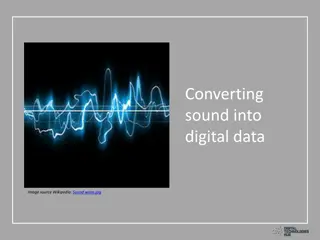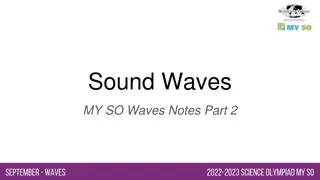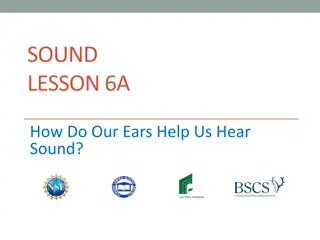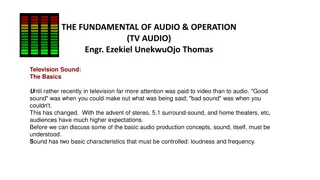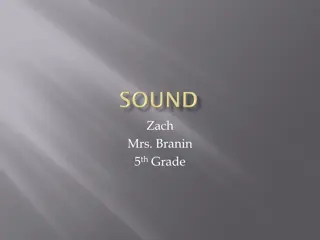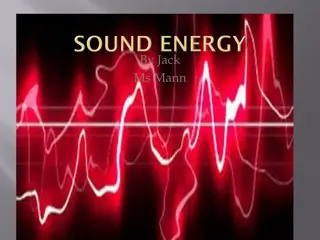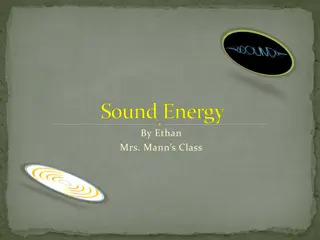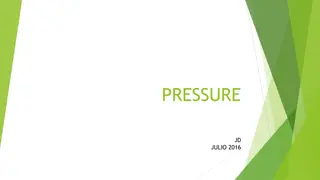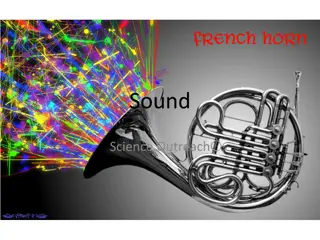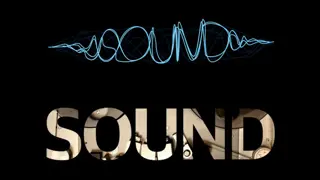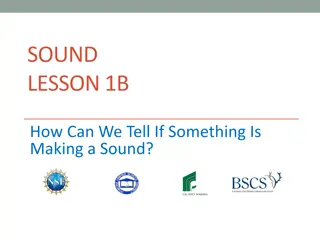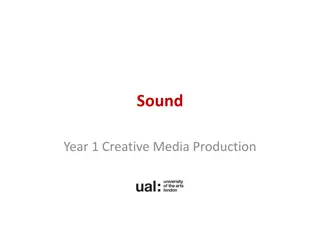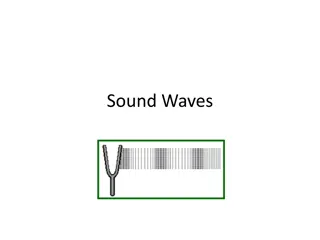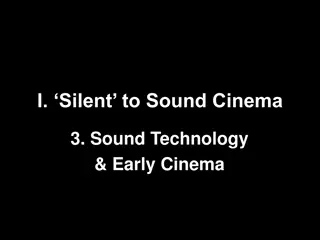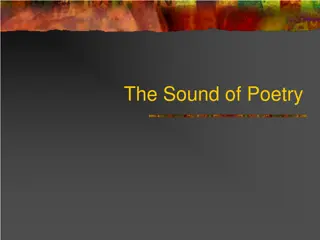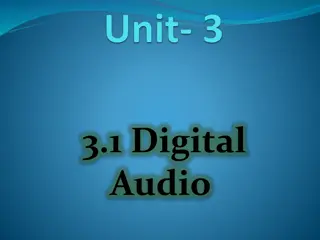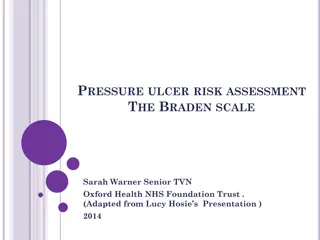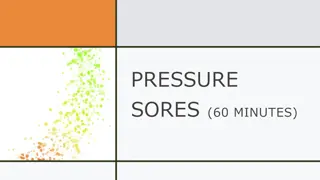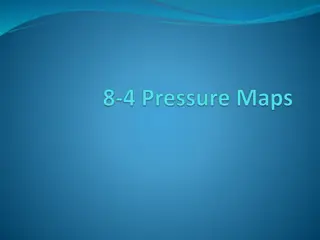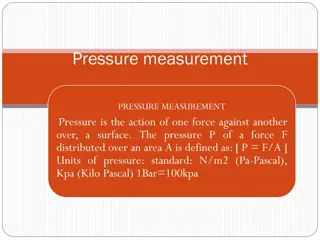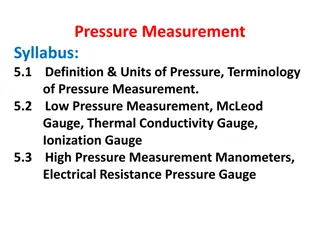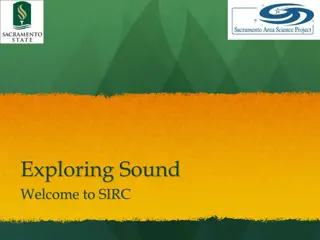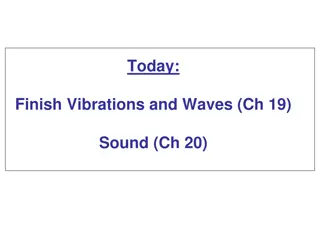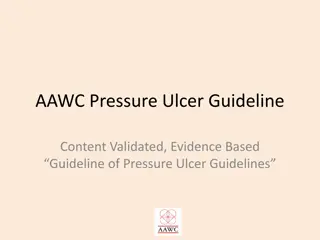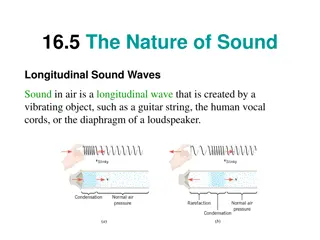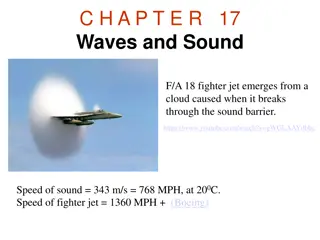Indian Renters Offers Reliable Sound System on Rent for Every Occasion
Experience the convenience of hassle-free sound rentals with Indian Renters' Sound System on Rent services. Our user-friendly booking process, flexible rental options, and prompt delivery ensure a seamless experience from start to finish. Whether you need sound systems for weddings, concerts, or cor
10 views • 3 slides
Understanding Fluid Pressure in Oil Field Hydraulics
Explore the fundamentals of fluid pressure including pressure basics, unit conversion, fluid weight constants, true vertical depth, and hydrostatic pressure in the context of oil and gas technology programs. Learn how to calculate pressure gradients, understand the impact of fluid density on pressur
1 views • 40 slides
Understanding the Conversion of Sound to Digital Data with ADC
Sound waves are converted into digital data using an Analog-to-Digital Converter (ADC) to enable computer processing. The ADC captures snapshots of the sound wave at specific intervals, turning them into numerical codes that computers can interpret. The sample rate determines the frequency of these
1 views • 18 slides
Influence of Environmental Factors on Sound Pressure Levels
In this study, the relationship between sound pressure, particle velocity, and the acoustic impedance is explored in the context of varying humidity, temperature, and barometric pressure. The ideal gas law is used to determine the density of both dry and humid air, considering parameters such as par
1 views • 14 slides
Understanding Sound Waves and How They Travel
Explore the fascinating world of sound waves and their behavior as they travel through various mediums. Learn about the generation of longitudinal waves, the importance of a medium for sound propagation, and the factors influencing the speed of sound such as elasticity, density, and temperature. Dis
2 views • 15 slides
Measurement Methods for Pressure Evaluation
The content describes the measurement of pressure using various methods such as Bourdon pressure gauge, diaphragm pressure gauge, and McLeod gauge. It explains the principle of McLeod vacuum gauge, the operation of the gauge, and the components involved. The McLeod gauge works by compressing a known
3 views • 27 slides
Understanding Horizontal Distribution of Air Pressure and Pressure Belts on the Globe
The horizontal distribution of air pressure and pressure belts on Earth is characterized by isobars, indicative of high and low pressure systems. The regular zonal distribution of pressure belts is affected by the uneven distribution of land and water. Pressure belts are not solely induced by temper
1 views • 7 slides
Understanding Pressure Measurement and Hydrostatic Forces on Surfaces
Measurement of pressure using various gauges like Bourdon and Diaphragm Gauge, different types of pressure gauges like Bellows and Dead Weight Pressure Gauge are discussed. Piezometer and different types of manometers for pressure measurement are also explained. Additionally, the concept of hydrosta
2 views • 11 slides
Exploring How Our Ears Help Us Hear Sound
Discover the intricate relationship between our ears and the sounds we hear. Uncover key science ideas about sound transmission and the role of our ears in capturing and interpreting sound waves. Engage in hands-on activities with kazoos and wax paper to understand vibration and sound detection. Sha
1 views • 17 slides
Understanding Audio Basics in Television Operations
Until recently, television focused more on video than audio. However, with advancements like stereo and surround sound, audience expectations have risen. This article delves into the fundamental characteristics of sound – loudness and frequency – and explores the various decibel levels in differ
6 views • 33 slides
Understanding Sound Waves and Vibration in Music
Dive into the world of sound waves and vibrations with this educational content. Explore how vibrations spread from vibrating objects, how different instruments produce sound, and the concepts of compression, rarefaction, solids, liquids, and gases in relation to sound. Discover the factors that aff
0 views • 9 slides
Understanding Pressure in Physics and Daily Life
Explore the concepts of force, pressure, and liquid pressure in physics, and how they relate to daily life scenarios. Learn about the relationship between force and pressure, the effects of surface area on pressure, and the application of pressure in everyday objects. Discover the significance of li
0 views • 13 slides
Colligative Properties in Solutions: Vapor Pressure, Freezing Point Depression, and Osmotic Pressure
Colligative properties such as vapor pressure lowering, freezing point depression, and osmotic pressure are characteristics of solutions that depend on the number of solute particles present. This text explores how these properties are related to the concentration of solute in a solution and how the
0 views • 14 slides
Understanding Pressure and Designing Objects to Alter It
Pressure is a crucial aspect of physics, and this content delves into the concept by comparing scenarios where a woman in stiletto heels or an elephant exerts pressure on the ground. It explains pressure calculation, discusses how objects designed to decrease or increase pressure work, and challenge
0 views • 22 slides
Understanding Sound Waves and Their Effects
Sound travels through sound waves, which can go through matter and interact with various surfaces in different ways. Factors such as frequency, energy, and surface characteristics affect how sound behaves, including pitch alteration, volume changes, reflection, absorption, and echo creation. Echoloc
0 views • 9 slides
Sound Energy by Ethan, Mrs. Mann's Class
Sound Energy by Ethan in Mrs. Mann's class is a captivating educational project showcasing different aspects of sound energy through engaging experiments and activities. The project, which delves into the fascinating world of sound waves and vibrations, provides valuable insights into the concept of
0 views • 10 slides
Understanding Hydrostatic Pressure in Fluid Statics
Explore the distribution of hydrostatic pressure in static fluids and its influence on solid surfaces, floating bodies, and submerged bodies. Learn about the equilibrium between pressure gradient and gravity force, along with concepts like gage pressure and vacuum. Discover how pressure varies in fl
0 views • 24 slides
Understanding Barometric Pressure and Its Impact on Altitude
Barometric pressure, also known as atmospheric pressure, is the force exerted by the weight of air on a specific area and varies with altitude. This pressure is crucial in various industries, such as cement production at high altitudes. Learn about how to calculate barometric pressure, its relation
0 views • 37 slides
Exploring the Science of Sound: Wavelengths, Speed, and Experiments
Delve into the fascinating world of sound with this engaging content, covering the fundamentals of sound waves, compression waves, the speed of sound in different mediums, and how to measure it. Get ready for a hands-on experiment to further your understanding of sound science!
0 views • 6 slides
Understanding Sound: Energy, Pitch, Transmission, and Speed
Sound is a form of energy that travels through a medium by vibrations. It carries intensity and pitch, with frequency determining pitch. Sound requires a medium to travel, unlike light. Elasticity and temperature of the medium affect the speed of sound transmission. Understanding how sound waves pro
1 views • 12 slides
Exploring Sound: How to Identify and Understand Sound Makers
Embark on a science lesson to investigate how to determine if something is making a sound. Explore evidence gathering, vibrating objects, and conducting experiments with rubber-band sound makers. Discover the importance of senses in detecting sound and develop predictions based on observations.
0 views • 15 slides
Understanding Different Types of Sound in Media Production
Explore the various types of sound in media products, including diegetic, non-diegetic, offscreen sound, sonic flashback, synchronous sound, asynchronous sound, ambient sound, contrapuntal sound, sound effects, and pleonastic sound. Learn how each type enhances storytelling and creates immersive exp
1 views • 14 slides
Exploring Essential Questions About Sound Waves
Delve into the fundamental aspects of sound waves through essential questions, observations of sound wave behavior, key facts, and measurements. Understand the nature of sound waves, including frequency, amplitude, speed of sound, and perception attributes like pitch and intensity level. Discover ho
0 views • 20 slides
Discovering the World of Sound: Chapter 12 Activities and Concepts
Experience a sound hunt activity, explore the science of vibrations and sound waves, and learn about how sound travels through different mediums. Dive into the fascinating world of echoes, dolphin navigation, and the human ear's perception of sound in this dynamic chapter.
0 views • 16 slides
Evolution of Sound Technology in Cinema: A Historical Perspective
Explore the transition from silent to sound cinema and the impact of sound technology on early cinema. James Lastra's work on sound in film and the significance of aural perception in modernity are highlighted, along with discussions on performance, inscription, and synchronization in sound imaging
0 views • 25 slides
Understanding the Science of Sound and Its Effects
Explore the fascinating world of sound, from the basic principles of resonance to the transmission of vibrations and the effects of sound energy on human beings and the environment. Delve into the concept of pitch, decibel levels, and wave patterns of sound to gain a deeper understanding of how soun
0 views • 13 slides
Understanding Digital Audio and Sound Characteristics in Multimedia
This content delves into key aspects of digital audio and sound characteristics in the realm of multimedia technology. It covers topics such as the nature of sound waves, the classes of sound including voice and music, digitizing sound, calculating audio data sizes, and the creation of digital audio
0 views • 51 slides
Understanding Blood Pressure Monitoring
Blood pressure monitoring is essential for maintaining overall health. This article explores the significance of blood pressure, the importance of monitoring it, and the methods used to measure blood pressure. It also delves into the clinical need for accurate blood pressure monitoring devices and t
0 views • 22 slides
Optimal Blood Pressure Levels to Prevent Cognitive Decline in Older Adults
Observational study at the 26th European Meeting on Hypertension suggests maintaining high-normal levels of systolic blood pressure between 130-145 mmHg may reduce cognitive decline and mortality risk in older adults. The complex relation between blood pressure and cognitive impairment is explored,
0 views • 9 slides
Understanding Pressure Ulcer Risk Assessment with the Braden Scale
Pressure ulcer risk assessment is crucial in healthcare settings to identify individuals at risk of developing pressure ulcers. The Braden Scale, developed in 1984, evaluates six key elements contributing to pressure ulcer development. It provides a standardized method for assessing risk levels base
0 views • 20 slides
Understanding Pressure Sores and Preventive Interventions for Bedridden Patients
Pressure sores, also known as pressure ulcers, are localized areas of tissue necrosis caused by prolonged pressure on skin and soft tissues. This can lead to serious complications, especially in bedridden patients like a 76-year-old man following a stroke. Preventive interventions include relieving
0 views • 26 slides
Understanding Air Pressure Through Pressure Maps
Explore the significance of air pressure in understanding weather patterns through pressure maps. Learn to interpret isobars, identify high and low pressure areas, analyze isobar intervals, and understand how air flows from high to low pressure areas. Enhance your meteorological knowledge and grasp
0 views • 6 slides
Understanding Pressure Measurement Techniques
Pressure measurement involves the action of force over a surface. Various sensing elements such as Bourdon tubes, diaphragms, and bellows are utilized for measuring pressure. Bellows sensors are flexible cylindrical enclosures, while Bourdon gauges use coiled tubes for pressure measurement. Differen
0 views • 11 slides
Comprehensive Guide to Pressure Measurement Methods
This comprehensive guide delves into the definition, units, and terminology of pressure measurement, covering low and high-pressure measurement techniques such as McLeod Gauge, Thermal Conductivity Gauge, Ionization Gauge, Manometers, and Electrical Resistance Pressure Gauge. It also explores the re
0 views • 56 slides
Exploring Sound: Engaging Activities for Teaching Young Learners about Sound Energy
Engage young learners in exploring sound energy through hands-on activities focusing on vibrating materials, sound production, and energy flow. Adapted from an adult-designed activity, this collaborative approach aligns with NGSS standards, encouraging students to investigate, observe, and analyze t
0 views • 10 slides
Understanding Sound: Vibrations, Waves, and Speed in Different Media
Explore the origins of sound through vibrations of objects like strings and vocal cords, and how these vibrations create longitudinal waves that travel through air. Learn about the speed of sound in different conditions, including moisture and temperature variations, and discover how sound travels i
0 views • 26 slides
AAWC Pressure Ulcer Guideline: Managing Pressure Ulcers Effectively
This content outlines the AAWC Pressure Ulcer Guideline, providing evidence-based recommendations for assessing, preventing, and treating pressure ulcers. The guideline emphasizes the importance of regular skin assessment, personalized care plans, and interdisciplinary wound care management to impro
0 views • 15 slides
Understanding Sound Waves: Nature, Properties, and Characteristics
Sound waves are longitudinal waves created by vibrating objects in air. They cannot propagate in a vacuum. Understanding how we hear involves exploring wave representations and the frequency ranges of sound waves, from infrasonic to ultrasonic. Sound also exhibits objective and subjective properties
0 views • 12 slides
Understanding Waves and Sound: A Visual Exploration
Explore the nature of waves and sound through a visual journey covering topics like transverse waves, longitudinal waves, water waves, periodic waves, wave speed, the speed of a wave on a string, the nature of sound, and the frequency of sound waves. Discover how waves carry energy, the different ty
1 views • 32 slides
High-Quality Van Sound Deadening in the UK - QT VanWerks
At QT VanWerks, we offer complete van sound deadening in the UK. We offer high-quality campervan insulation and carpet lining services. Our van conversions come with full sound deadening as standard. Our full sound deadening means a sound deadening u
0 views • 1 slides


